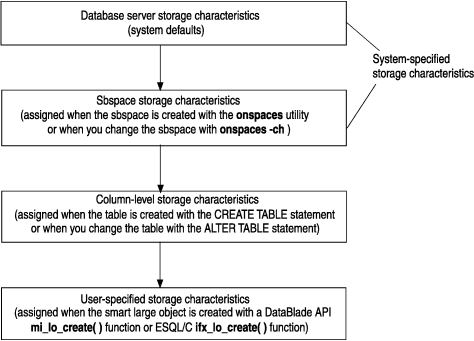Storage-characteristics hierarchy
HCL Informix® uses the storage-characteristics hierarchy to obtain the storage characteristics for a new smart large object.

| Storage information | System default value | Storage characteristic specified by onspaces utility | Column-level storage characteristic specified by the PUT clause of CREATE TABLE | User-defined storage characteristic specified by a DataBlade® API function |
|---|---|---|---|---|
| Size of extent | Calculated by smart-large-object optimizer | EXTENT_SIZE | EXTENT SIZE | Yes |
| Size of next extent | Calculated by smart-large-object optimizer | NEXT_SIZE | No | No |
| Minimum extent size | Four kilobytes | MIN_EXT_SIZE | No | No |
| Size of smart large object | Calculated by smart-large-object optimizer | Average size of all smart large objects in sbspace: AVG_LO_SIZE | No | Estimated size of a particular smart large object Maximum size of a particular smart large object |
| Maximum size of I/O block | Calculated by smart-large-object optimizer | MAX_IO_SIZE | No | No |
| Name of sbspace | SBSPACENAME | -S option | Name of an existing sbspace that stores a smart large object: IN clause | Yes |
For most applications, use the values for the disk-storage information that the smart-large-object optimizer determines. If you know the size of the smart large object, it is recommended that you specify this size as a user-specified storage characteristic, instead of as a system-specified or column-level storage characteristic.
For more information about any of the disk-storage information in Specifying disk-storage information , see Disk-storage information.
| Storage information | System default value | Storage characteristic specified by the onspaces utility | Column-level storage characteristic specified by the PUT clause of CREATE TABLE | User-defined storage characteristic specified by a DataBlade API function |
|---|---|---|---|---|
| Logging | OFF | LOGGING | LOG, NO LOG | Yes |
| Last-access time | OFF | ACCESSTIME | KEEP ACCESS TIME NO KEEP ACCESS TIME |
Yes |
| Buffering mode | OFF | BUFFERING | No | Yes |
| Lock mode | Lock entire smart large object | LOCK_MODE | No | Yes |
| Data integrity | High integrity | No | HIGH INTEG, MODERATE INTEG | Yes |
For more information about any of the attributes in Specifying attribute information, see Attribute information.
| Storage information | System default value | Storage characteristic specified by the onspaces utility | Column-level storage characteristic specified by the PUT clause of CREAT TABLE | User-defined storage characteristic specified by a DataBlade API function |
|---|---|---|---|---|
| Open-mode information | Default open mode | No | No | Yes |